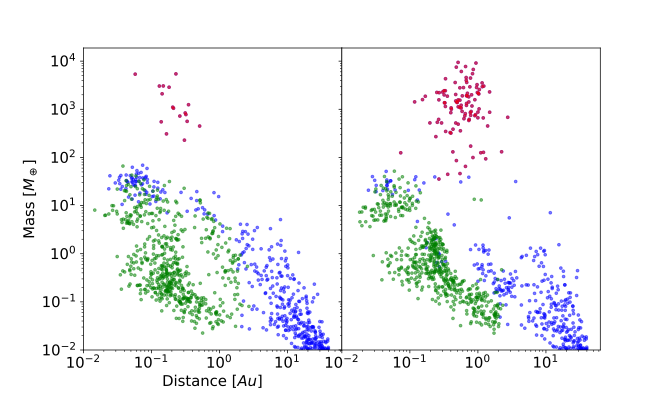A population level study on the influence of planetesimal fragmentation on planet formation
- Physics Institute, Uni Bern, Gesselschaftsstrasse 6, 3012 Bern, Switzerland
The size distribution of solids in the protoplanetary disk is still ill constrained [1] but is a vital parameter that influences planetary growth [2]. The typical size and spatial distribution of solids evolves throughout the planet formation process via collisions and radial drift. As the planets grow, they excite the mutual random velocities among planetesimals making their mutual collisions destructive which leads to fragmentation, reducing their typical size. This effect of self-interacting planetesimals has been found to inhibit or favor the formation of planets due to competing effects of easier accretion of smaller fragments and depletion by gas-drag induced drift [3-4]. However, previous studies have either focused on single planets and systems or have neglected concurrent effects like migration.
Therefore, we run planet formation simulations with the generation III Bern model [5] with a Eulerian 1D solid disks. The model tracks the growth and evolution of several planetary embryos from oligarchic growth to the final planetary system. We added to it a fragmentation toy model [6] to see the impact fragmentation has on planet formation. To see its influence on the diverse types of exoplanets we make use of a population synthesis approach to investigate larger parts of the parameter space [7]. This allows us to have a more complete picture of what influence the collisional evolution of planetesimals has on planet formation and to study the effects that arise from its interplay with the formation of multiple planets in the same system.
In figure 1, we show two exemple synthetic planet populations of 1000 systems with (right) and without (left) the added fragmentation model. We find multiple interesting features in our synthetic populations that arise from the fragmentation of planetesimals. The fragmentation lends more importance to specific locations in the disk where growth is enhanced like the ice line and the inner disk. In addition, it enhances the formation of giants.
In conclusion, there are significant differences in synthetic populations when including or neglecting fragmentation. This suggests that the addition of fragmentation to global planet formation models is important as a self-consistent solid disk description is vital to understand planet formation.

In figure 1. Comparison of a synthetic exoplanet population without (left) the added fragmentation model and one with (right). The semi major axis (in AU – log scale) is plotted on the x-axis and the planetary mass (in Earth masses – log scale) on the y-axis. Both populations are shown at an age of 5 Gyr. The Red points refer to planets with more envelope than core mass, the blue ones are icy planets (ice mass fraction larger than 1%) and the green points are rocky planets (ice mass fraction smaller than 1%).
References:
[1] Helled, R. & Morbidelli, A. 2021, in ExoFrontiers (IOP Publishing)
[2] Fortier, A., Alibert, Y., Carron, F., Benz, W., & Dittkrist, K.-M. 2012, A&A, 549, A44
[3] Guilera, O. M., de Elía, G. C., Brunini, A., & Santamaría, P. J. 2014, A&A, 565, A96
[4] Chambers, J. 2008, Icarus, 198, 256
[5] Emsenhuber, A., Mordasini, C., Burn, R., et al. 2021, A&A, 656, A69
[6] Ormel, C. W. & Kobayashi, H. 2012, The Astrophysical Journal, 747, 115
[7] Emsenhuber, A., Mordasini, C., Burn, R., et al. 2021b, A&A, 656, A70
How to cite: Kaufmann, N. and Alibert, Y.: A population level study on the influence of planetesimal fragmentation on planet formation, Europlanet Science Congress 2022, Granada, Spain, 18–23 Sep 2022, EPSC2022-135, https://doi.org/10.5194/epsc2022-135, 2022.

